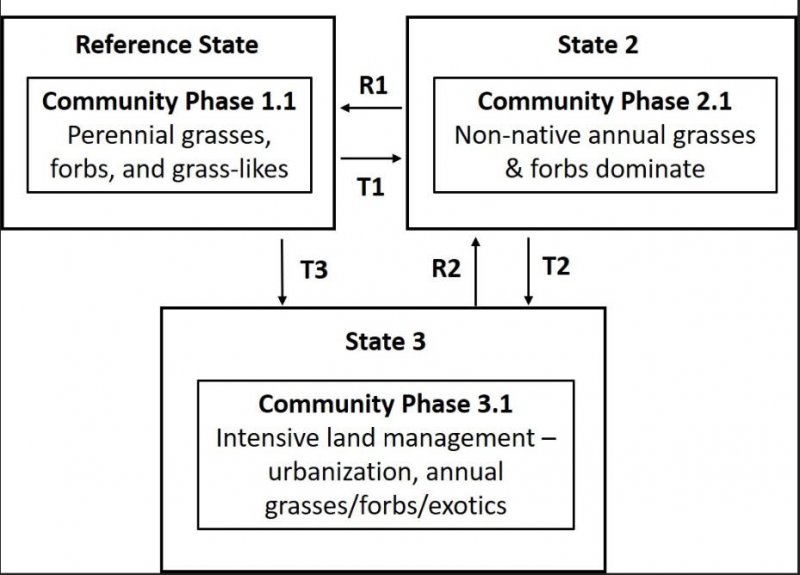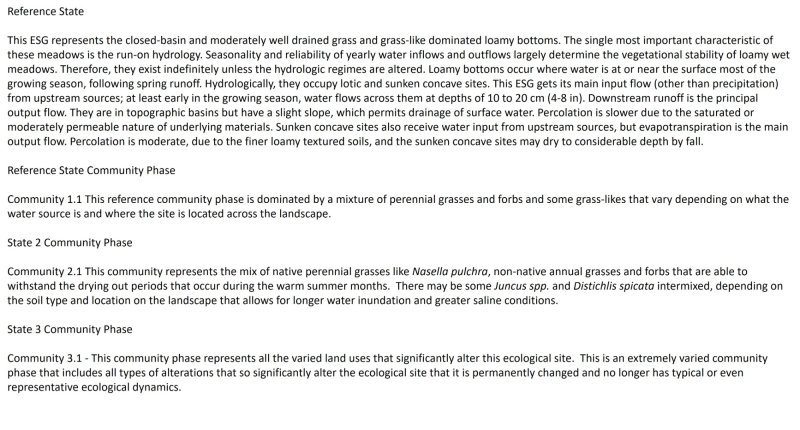Ecological site group R014XG907CA
Loamy Bottom
Last updated: 09/07/2023
Accessed: 12/19/2025
Ecological site group description
Key Characteristics
None specified
Provisional. A provisional ecological site description has undergone quality control and quality assurance review. It contains a working state and transition model and enough information to identify the ecological site.
Physiography
This ESG is typically found on nearly level to gently sloping basins, alluvial fans, stream terraces, and flood plain steps. Slopes are generally from 0 to 2 percent. Elevations range from 100 to 1500 feet.
Climate
The average annual precipitation in this area is 11 to 53 inches (272 to 1,353 millimeters). This ESG differs from the Dry Loamy Bottoms site by averaging between 30-40 inches a year. The higher amounts of precipitation occur at the higher elevations in the area north of San Francisco. Most of the rainfall occurs as low- or moderate-intensity, Pacific frontal storms during winter. This area is very dry from midspring to midautumn. Snowfall is rare. The average annual temperature is 54 to 61 degrees F (12 to 16 degrees C). The freeze-free period averages 315 days and ranges from 265 to 365 days. It is longest near the coast, and it becomes shorter with elevation.
Soil features
Soils in this ESG are extremely varied from fine-loamy to sandy loams, poorly drained to well drained, and a water table near the surface for part or more of the year. These soils are very fertile and moist soils for agriculture and thus extensive acres have been converted to croplands and vineyards.
Some representative soils include:
Bale, a fine-loamy, mixed, superactive, thermic Cumulic Ultic Haploxerolls
Blucher, a fine-loamy, mixed, superactive, thermic Fluvaquentic Haploxerolls
Cole, a fine, mixed, superactive, thermic Pachic Argixerolls
Gielow, a fine-loamy, mixed, superactive, mesic Cumulic Endoaquolls
Lupoyoma, a fine-silty, mixed, superactive, thermic Cumulic Ultic Haploxerolls
Still, a fine-loamy, mixed, superactive, thermic Cumulic Haploxerolls
Vegetation dynamics
This ESG covers the areas of the valleys in MLRA 14 that were at one time part of a vast complex of marshes, tidal flats, estuaries, wetlands and wet meadows. The urbanized landscape in the valleys within this MLRA that exists today makes it difficult to imagine the natural landscape prior to human development.
These loamy bottoms were likely the loamy-textured depressional and deposition areas and isolated oxbows that were created from the network of freshwater and salt marshes, rivers and streams that ran through these valleys as their seasonal and tidally influenced flood waters stretched across the floodplains and terraces in spring and deposited sediment as they receded during summer. Once the area began to be settled, many of these water dominated ecosystems were drained, leveed, cleared for crops and other agriculture, and urbanized.
As this landscape was de-watered and houses and agriculture took over, the water table for many of these habitats moved deeper and deeper, creating soils that would no longer offer the available soil moisture for many of the plants that had evolved with the hydrologic function of the natural system that no longer existed. These loamy basins may have remained wetter than many of the surrounding soils, due to their prolonged available water capacity and their depressional location on the landscape. The variable range in soil textures will dictate the species composition and production, with the finer soils holding more water that results in more native perennials and forbs and higher annual production overall. The coarser textures will dry out more rapidly through both drainage and evapotranspiration in the summer months making them less hospitable for many of the native perennial grasses and more dominated by annual grasses and forbs. Annual production will still be higher than the other ESGs in bottoms, due to the loamy textures which provide decent available water and slightly slower but still well drained soil conditions.
Historically, this site may have looked similar to the CWHR wet meadow classification, however with the introduction of non-native annual grasses and the impacts from fragmentation, continued de-watering, and human alterations such as homes and roads, this site now reflects a lower producing, dry, annual grassland.
Currently, where this site is not under cultivation or urban developments, it is dominated by non-native annual grasses. These include wild oats, soft chess, ripgut brome, red brome, wild barley, and foxtail fescue. Common forbs include broadleaf filaree, redstem filaree, turkey mullein, true clovers, bur clover, popcorn flower, and many others. Perennial grasses, found in moist, lightly grazed, or relic prairie areas, include purple needlegrass and blue wildrye and areas of intermittent ponding will be have sedges and rushes. Species composition is also related to water availability with greater amounts of relic perennial grasses in areas of greater precipitation or soil moisture.
Information from:
John G. Kie
California Wildlife Habitat Relationships System
California Department of Fish and Game
California Interagency Wildlife Task Group
Major Land Resource Area
MLRA 014X
Central California Coastal Valleys
Stage
Provisional
Click on box and path labels to scroll to the respective text.


